|
Events convened on Monday,
13 December 2004
|
|
Cities for climate protection: Mayors
fight global warming
Presented by the International Council
for Local Environmental Initiatives (ICLEI)
|
|
|
|
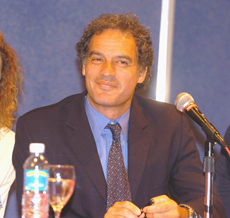 |
|
Anibal Ibarra, Mayor of Buenos Aires,
Argentina, welcomed the Mayors of other
cities involved in local actions to
combat climate change, highlighting that
cities play a crucial role in designing
and implementing climate change-related
policies |
|
Anibal Ibarra, Mayor of Buenos
Aires, Argentina, stressed cities’
central role in addressing climate
change and the importance of
involving all cities in designing
and implementing mitigation
policies.
Ross Rocky Anderson, Mayor of Salt
Lake City, US, outlined “Salt Lake
City Green,” an environmental
initiative applied to municipal
operations, businesses and
individuals, including programs
designed at improving air quality
and reducing greenhouse gas (GHG)
emissions. He explained that Salt
Lake City implements a
high-performance buildings project
aimed at minimizing the
environmental impacts of
construction, through the use of
energy-efficient lighting, among
others. He noted that ICLEI had been
instrumental in implementing “Salt
Lake City Green,” by providing
necessary software and planning
materials.
Patricia Ross, Councilor of
Abbotsford, Canada, highlighted
actions against the construction of
a fossil-fuel power plant, and
municipal environmental programs in
the field of private and public
transport, corporate environmental
responsibility, waste conversion,
and domestic energy consumption.
|
|
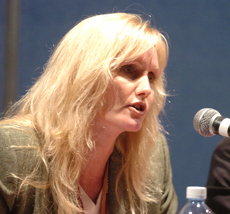 |
|
Patricia Ross, Councilor of Abbotsford,
Canada, said her city works with the
corporate community, using incentives
such as free advertising to encourage
businesses to become environmentally
responsible |
|
Domenico Zampaglione, Council member
of Milan, Italy, said Milan’s
activities to reduce GHG emissions
focus on: the development of
co-generation; provision of
incentives to use natural gas and
efficient heating systems
technologies; and the use of
renewable energy sources. He said
Milan’s urban transport and transit
system strategy promotes alternative
fuels and low impact motorization
systems, and noted that the city
aims to increase its use of hydrogen
fuel cells.
Marcello Lelis, Council member of
Palmas, Brazil, highlighted his
city’s preparation of an inventory
for GHG emissions, use of organic
waste for energy, and participation
in Brazil's energy efficiency
program. He said Palmas had
developed its Project Design
Document, and noted that the city’s
urban carbon sequestration project
involves all sectors of
environmental management.
Imma Mayol, Deputy Mayor of
Barcelona, Spain, indicated that
Barcelona’s strategic ten-year plan
is to reduce power use by 17% and
GHG emissions by 20% by 2012,
through the implementation of
programs related to
energy efficiency
and use of renewable
energy. She noted
the adoption of
construction
standards and
measures to reduce
emissions from the
public transport
sector.
|
|
Bob Price, ICLEI,
invited the
panelists to sign
the Local Government
Declaration, which
stresses mayors’
commitment to
continue actions to
combat climate
change and seek
additional resources
from the private
sector and central
governments for
implementation. He
presented ICLEI’s
activities related
to the World
Environment Day to
be held in San
Francisco, from 1-5
June 2005, and the
Target Zero
initiative, aimed at
gathering commitment
from cities around
the world to exceed
the Kyoto Protocol
targets and achieve
zero emissions
growth.
Discussion:
Participants
enquired about
various cities'
programs. Regarding
Buenos Aires, the
adoption of an
atmospheric quality
standard act was
noted, as well as
the focus of the
city’s climate
protection program
on expanding the
subway system,
increasing public
streetlights
efficiency, and
promoting
non-motorized
transport and less
carbon-intensive
fuels.
|
|
|
Climate change Forum: Presentations of
new non-Annex I National Communications,
and on financial and technical support
Presented by the UNFCCC Secretariat
|
|
|
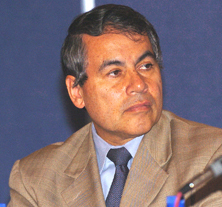 |
|
Walter Vergara, World Bank, said
National Communications need to be
coordinated closely with adaptation
activities |
|
Martha Perdomo,
UNFCCC, said 120
initial
communications had
been submitted by
non-Annex-I Parties,
representing 80% of
submitted National
Communications,
while 65 non-Annex I
Parties were in the
process of preparing
their second
National
Communication.
Dominique Revet,
UNFCCC, reported on
the workshop of the
Consultative Group
of Experts on
National
Communications from
non-Annex I Parties,
noting that training
material for
vulnerability and
adaptation is under
preparation. He said
a global workshop on
mitigation is
planned for
September 2005.
Yamil Bonduki, UNDP,
spoke on support
provided to
non-Annex I
countries preparing
National
Communications,
including
self-assessment
exercises and
preparation of
project proposals.
He said the National
Communications
Support Programme of
the Global
Environment Facility
(GEF), UNDP and UNEP
will assist all
non-Annex I Parties
to follow a
flexible,
needs-based
approach, and
identified core
areas including
inventories,
adaptation,
mitigation,
technology transfer,
and integration of
climate change
issues into
development
policies.
|
|
Ian Tellam, ETC
Foundation,
presented the
Netherlands’ Climate
Change Studies
Assistance Programme
(NCCSAP),
implemented by the
Netherlands Ministry
of Foreign Affairs
and involving 14
non-Annex I
countries. He said
the programme aims
at assisting
developing countries
in the preparation,
formulation,
implementation and
evaluation of
climate change
policies, and in
raising awareness
about climate
change. He said the
NCCSAP study areas
include water,
agriculture, health
and disaster
preparedness.
Walter Vergara,
World Bank,
discussed financial
and technical
assistance for
second National
Communications,
identifying
small-island and
high-mountain
ecosystems as
specially vulnerable
areas. Vergara
presented two
support instruments,
namely the GEF’s
Strategic Priority
on Adaptation (SPA)
and the Climate
Change Special
Program to support
SPA project
preparations.
R.P. Kabwaza,
Malawi’s Ministry of
Mines, Natural
Resources and
Environment,
outlined the
preparation process
for the Initial
National
Communication of
Malawi, and
recommended, inter
alia, improving
energy balance
sheets, enhancing
human capacity,
increasing funding
for future National
Communications, and
preparing National
Action Plans.
Nagmeldin Elhassan,
Sudan’s Higher
Council for
Environment and
Natural Resources,
presented Sudan’s
First National
Communication,
noting that the
expected climate
change impacts
include decreased
crop production
areas, a decline of
crop yields,
increased water
deficits, and
changes in the
distribution and
intensity patterns
of malaria.
|
|
|
Technology transfer and the UNFCCC:
Practical approaches for responding to
developing country priorities
Presented by the Secretariat of the
UNFCCC
|
|
 |
|
Richard Bradley, IEA, said a sustainable
energy system requires more rapid
technology transfer |
|
Nick Campbell, International Chamber
of Commerce, highlighted the need to
exploit business opportunities,
research and development (R&D) and
technology in addressing climate
change.
Margaret Martin, Natural Resources
Canada, outlined the activities of
the Expert Group on Technology
Transfer of the Subsidiary Body on
Scientific and Technological Advice
emphasizing the importance of
enabling environments in attracting
sustainable investment.
Larisa Dobriansky, US Department of
Energy Policy and International
Affairs, emphasized the role of
technology needs assessment, and
said financing is a major barrier to
cleaner technologies. She stressed
the role of governments in creating
enabling environments and bringing
together relevant stakeholders.
Richard Bradley, IEA, said 90% of
the increase in global energy demand
by 2030 will be met by
fossil fuels based on
policies enacted in July
2004, but stressed that
alternative policies could
reduce GHG emissions by 16%
and create savings by
avoiding supply-side
investment in fossil fuel
technologies. |
|
Highlighting the role of
local manufacturing and
engineering in technology
transfer, James Wolf,
American Standard Companies,
said technologies marketed
through American Standard
Companies are now produced
in China.
Brian Flannery, ExxonMobile,
highlighted the success in
phasing-out leaded gasoline
in Sub-Saharan Africa,
through a public-private
partnership involving
inter-governmental
organizations, governments,
NGOs and businesses.
Sergio Ennes, Clean Air,
focused on renewable energy
potential in Brazil,
especially wood gasification
in the Amazon region,
emphasizing that 400,000
tons of carbon dioxide
emissions could be
eliminated during the next
ten years.
Norine Kennedy, United
States Council for
International Business,
emphasized the need to
rapidly transfer technology.
She said sectoral approaches
can yield benefits, but
stressed that cross-sectoral
linkages must not be
ignored.
|
|
Energy Perspectives on climate change
Presented by the International Energy
Agency (IEA)
|
|
 |
|
Lewis Fulton, IEA, said biofuels are
cheaper than gasoline in some countries
such as Brazil, and can replace 10% of
global gasoline use at low cost |
|
Richard Bradley, IEA, presented
global trends in energy consumption
and carbon emissions, noting that
80% of emissions in 2002 originated
from 22 countries representing 80%
of the global gross domestic product
(GDP).
Laura Cozzi, IEA, presented on the
world energy outlook. She said
without major policy changes, global
emissions will grow by 62% between
2002 and 2030, with developing
countries’ emissions surpassing
those of developed countries in the
2020s.
Cédric Philibert, IEA, discussed
solar power technologies, stressed
that their market potential depends
on geographic location and sunlight
levels, and noted that existing
facilities are concentrated in
countries that are not bound by
Kyoto Protocol commitments, such as
the US, Australia and some
developing countries. He outlined
IEA’s work to facilitate
international collaboration on solar
energy but stressed that national
policies remain decisive.
Lewis Fulton, IEA, said long-term
transport technologies such as
hydrogen fuel cells and electric
engines face significant obstacles
such as high production costs and
storage difficulties, and that
market penetration of hydrogen
technologies before 2020 is
unlikely. Fulton stressed the
promise of short-term options such
as fuel economy improvements,
biofuels production, and changes in
transport systems, emphasizing that
they can produce dramatic carbon
reductions at very low costs.
|
Martina Bosi, IEA, presented a study
on industrial competitiveness under
the EU Emissions Trading Scheme. She
stressed that, by 2020, carbon
reductions will cause only modest
cost increases in energy-intensive
industries, with projected profit
losses ranging from 0.4-8% and price
increases ranging from 0.5-3.4%.
Nicolas Lefevere-Marton, IEA,
presented a new framework for
measuring energy security,
describing its application to four
countries, and said energy security
will be affected by fuel “market
concentration” of oil producers,
which is projected to increase by
75-89% by 2030.
Antonio Pflüger, IEA, spoke on
technological options for reducing
carbon, including energy-efficiency
improvements, renewable energy, and
carbon storage. He stated that
significant reductions in energy
consumption can be achieved at low
or even negative costs, and would
lead to energy security
improvements, stronger economic
competitiveness, and climate
mitigation. Noting a decrease in
public funding for R&D related to
renewable energy, he identified a
need for incentives to create market
conditions favorable to
technological innovation.
|
|
Options and insights: Advancing the
international climate effort
Presented by the Pew Center
|
|
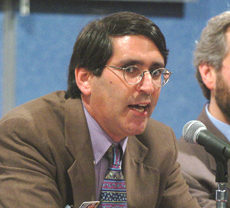 |
|
Daniel Bodansky, University of
Georgetown, said while some proposals
for the post-Kyoto era build on the
Kyoto Protocol and the Kyoto mechanisms,
others would radically change the design
of the regime |
|
Elliot Diringer, Pew Center,
introduced the ongoing “Climate
Dialogue” concerning the post-Kyoto
era and aiming to develop “strawman
proposals” on how to strengthen the
climate regime. He said key issues
include how to: engage major
emitters; provide flexibility to
accommodate national circumstances;
integrate climate and development;
adopt activity-based approaches;
couple near-term action with
long-term strategies; and address
adaptation needs.
Jonathan Pershing, World Resources
Institute (WRI), said in order to
assist the “Climate Dialogue,” the
WRI has compiled information on: GHG
emissions, population and gross
domestic product (GDP); carbon
intensity; per capita emissions;
emissions projections; and
vulnerability and capacity.
Daniel Bodansky, University of
Georgia, introduced the Pew Center’s
report “International Climate
Efforts beyond 2012: A Survey of the
Process.” He said the report
includes proposals on future
negotiations
within or outside the UNFCCC
framework, the types of mitigation
commitments required, adaptation,
and implementation and compliance. |
|
Amb. Michael Zammit Cutajar, Malta,
said the “Climate Dialogue” provides
political and economic reality
checks and aims to provide options
rather than set solutions.
Gao Feng, Chinese Ministry for
Foreign Affairs, said future
negotiations should be based on the
UNFCCC as the legal and political
framework, use sustainable
development as a key principle,
adopt a bottom-up approach, and
combine technology with policies and
measures.
Chadrashekhar Dasgupta, The Energy
and Resources Institute (Teri), said
the downward trend in carbon
intensity in some developing
countries may not entail the
decoupling of growth and emissions
in the long-term due to inter-sectoral
shifts. |
|
Global collaboration for addressing
energy issues in developing countries
Presented by the Government of Japan
|
|
 |
|
Akio Morishima, Japan, said Japan’s
energy consumption per unit of
production has decreased by 50% since
1973 and today amounts to merely
one-third that of the US |
|
Hisashi Ishitani, Keio University,
presented a report on global energy
issues, noting that by 2030 global
energy demand will increase by 60%
and energy investments in developing
countries will reach US$7.9
trillion, exceeding those in
developed countries. He identified
possible solutions to energy
problems, including government
cooperation on capacity building,
private sector collaboration in
improving energy efficiency,
encouraging “unilateral CDM”
projects, and simplifying
additionality tests and baseline
methodologies.
In a panel discussion, Amb.
Chandrashekhar Dasgupta, India, said
CDM plays only a marginal role in
mitigating emissions from developing
countries, and recommended
developing nuclear energy CDM
projects, using soft credits to
improve technology transfer, and
outsourcing technological research
to reduce costs.
Gao Feng, Chinese Ministry of
Foreign Affairs, said the Kyoto
Protocol process presents a historic
opportunity to solve energy problems
and achieve sustainable development,
pointed out that CDM is playing a
marginal role in reducing emissions
in developing countries, and
stressed that the number of CDM
projects depends on the size of the
carbon market. |
|
 |
|
Gao Feng, Chinese Ministry of Foreign
Affairs, stated that projected
investments in China’s energy sector
between 2000 and 2020 are US$1000
billion, and stressed that the number of
CDM projects depends on the size of the
carbon market |
|
Amb. Masaki Konishi, Japan, listed
possible actions toward a low-carbon
economy, including changing
lifestyles, implementation of CDM
projects, integration of trade and
development for technology transfer,
and use of technology as an
incentive for universal
participation in current and future
international policy frameworks.
Andrei Marcu, International
Emissions Trading Association,
stressed the central role of market
mechanisms in technology development
and transfer, identified
cost-effective use of capital as a
key policy driver, and advocated a
shift to a sector-based versus
country-based approach to climate
change.
Akio Morishima, Japan’s Industrial
Structure Council, presented Japan’s
efforts to reduce GHG emissions,
indicated that Japan has the highest
energy efficiency among developed
countries, and stressed that this
makes its marginal abatement costs
very high. |
|
Harlan Watson, US Department of
State, said the private sector
accounts for 90% of all foreign
investments in the energy sector,
stressed the importance of
mainstreaming climate change in the
sustainable development policies of
developing countries, and called for
win-win solutions to poverty and
climate change. |
|
Business perspectives on CDM
additionality and baselines
Presented by the Business Council for
Sustainable Energy (BCSE)
|
|
 |
|
Regarding the CDM EB’s additionality
tool, Marcelo Junqueira, Econergy, said
analyzing the impact of CDM registration
on a project is unnecessary |
|
Lisa Jacobson, BCSE, noted that her
organization promoted the prompt
start of small-scale CDM projects
and the standardization of
baselines, while opposing investment
additionality for CDM projects.
Jose Eduardo Sanhueza, CDM Executive
Board (EB), stressed that
additionality is a crucial concept
despite it never having been
mentioned in the Kyoto Protocol or
the Marrakesh Accords. He noted that
the EB’s additionality tool is not
mandatory and project developers can
continue to develop other tools.
Marcelo Junqueira, Econergy,
discussed the additionality of the
Vale do Rosario CDM project, based
on a barrier test, and lamented the
EB’s additionality tool.
Tod Delaney, First Environment, said
additionality analyses remain
difficult to perform, validators’
decisions based on these analyses
are highly
subjective and that these factors
introduce uncertainty into CDM
validations. |
|
Horst Biedermann, European
Insulation Manufacturers
Association, cautioned that the EU
may fail to meet its Kyoto
commitment if the emissions
reductions potential of buildings is
not considered.
Mark Trexler, Trexler Climate and
Energy Services, said the CDM’s main
problem is the imbalance between
supply and demand resulting from the
US and Australian opposition to
ratifying the Kyoto Protocol, since
the supply remains the same. He
concluded that since the demand for
carbon credits cannot be increased,
the supply needs to be reduced.
John Kadyszewski, Winrock
International, said a way to reduce
the CDM supply is to strengthen the
sustainable development objective.
Jorge Barrigh, Corporación Andina de
Fomento, called for supplementary
proposals on additionality from
business to ensure that the CDM will
deliver.
Ben Pearson, CDM Watch, stressed
that the CDM does not imply new
emissions reductions but transfers
the reduction from an Annex I to a
non-Annex I country, noting that
“fake Certified Emissions
Reductions” that are not additional
will undermine the Kyoto reduction
targets. |
Arctic climate impact assessment
Presented by the Government of Iceland
|
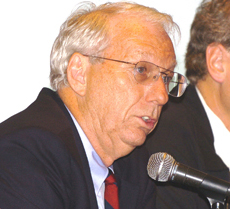 |
|
Robert Corell, ACIA, indicated that even
with reductions in carbon dioxide
emissions over the next century
following IPCC’s B2 scenario
commitments, it would take 1000 years
for sea levels to stop rising, due to
thermal expansion and ice melting |
|
Robert Corell, Arctic Climate Impact
Assessment (ACIA), introduced the
report “Impacts of a warming
climate,” a scientific assessment of
the social, economic and
environmental impacts of climate
change in the Arctic. He said from
1979-2003 the extent of the sea ice
in the Arctic basin has decreased by
10% and the thickness by 40%. He
explained how this reduces surface
reflectivity and accelerates
warming, and said the assessment
predicts a sea level rise exceeding
the 20-90 centimeters predicted by
the Intergovernmental Panel on
Climate Change.
Pål Prestrud, ACIA, noted that
global circulation models all
predict a 40-50% decrease in Arctic
sea ice between 2010-2090,
indicating that populations of
ice-dependent Arctic species will
decline. He said with reduced ice
cover, the navigation season will
increase from 30 to 120 days, noting
with irony that this will increase
the accessibility of Arctic fossil
fuel reserves.
Terry Callaghan, Abisko Scientific
Research Station, described how
Arctic vegetation zones are expected
to shift, with the treeline moving
north and displacing tundra habitats
in some areas. He explained how
rapid climate change will result in
forest fires, pest outbreaks and
disease, and indicated that coastal
communities will be subject to
coastal erosion, increased flooding,
and coastal retreat. He noted that
thawing permafrost will affect
ecosystems and result in increased
emissions of methane, as well as
disrupting transportation and
destabilizing buildings and other
infrastructure. |
|
|
Lars-Otto Reiersen, Arctic
Monitoring and Assessment Programme,
described the effects of climate
change on indigenous peoples in the
Arctic. He indicated that the
environment has become less
predictable, that travel modes must
be adapted to thinning of the ice,
and that access to resources has
become restricted with negative
impacts on human health, food
security and culture. |
|
|
|







